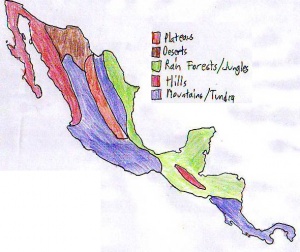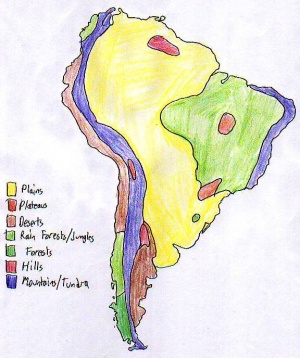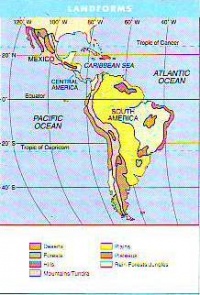World Cultures Portfolio/Latin America
From ThePlaz.com
World Cultures Latin American Report about Landforms
Intro/Basics - Africa - Middle East - South Asia - China - Japan - Korea - Latin America
Only spent half a day on this unit World Cultures Daily Questions
Notebook
- Page 101 - Central American Map, South American Map, Geo Notes, Page 2
- Page 102 - Latin American Notes, Page 2, Page 3, Page 4, Page 5, Page 6, Page 7, Page 8, Page 9
Portfolio
- Portfolio
- Landforms Report
Africa: HDI Graph Reflections - Decolonization Report
Middle East: Population Density Report - Essay: A Peaceful Vacation
South Asia: Rainfall Report - South Asia Comparisons Graph - Postcards
China: Sphere of Influences Report - Mao Button Journal
Japan: Natural Resources Report - Japanese Violence Journal
Korea: Physical Map Report
Latin America: Landforms Report
Worldwide: T-Shirt Trade Report
Latin America stretches 5,500 long miles from the Rio Grande River to the tip of Cape Horn (Blue Textbook 441). The region receives its name from the Latin people who first "discovered" it centuries ago (Blue Textbook 441). The region stretched from tropical rain forests to icy wastelands near Antarctic (Blue Textbook 441). Latin America, a vast collection of different sub-regions, means that not just one story exists about Latin American landforms. Latin America contains Mexico, 7 nations of Central America, Puerto Rico and 13 other Caribbean nations, along with 14 nations of South America (Blue Textbook 441). Latin America covers 20% of the earth's land surface area.
Much of the geography of Latin America gets affect by the La Cordillera mountain range (Blue Textbook 441). These mountains run the entire length of Latin America and even extend into North America (Blue Textbook 441). The name might not sound familiar because the mountains have different names in different regions. The United States calls its section the Rocky Mountains. In Mexico, the Sierra Madres affect most of Mexico. The chain continues down through Central America, no doubt the force which created that land bridge. In South America, the mountains hug the western cost of the country leaving little coastal plains. The mountains, as seen before, cut of the rain clouds from crossing them. Thus the Atacama Desert exists (Blue Textbook 441). Some parts of it have not received rain in 400 years (Blue Textbook 441).
The land bridge of Central American can also explain a lot. Thousands of years before the Europeans "discovered" South America, native peoples must have wondered across that thin strip of land to find the vast continent of South Africa. These people must have also crossed over from Russia centuries before that. That land bridge, however, no longer stands.
In the north of Latin America lies Mexico. Below the Rio Grande the deserts of the American west continue. Although the map doesn't show it, the Baja Peninsula can also be considered a desert. The Sierra Madera mountains and Central Plateau make this not a good spot for agriculture.
Moving down into Central America, one finds rain forests. Rain forests grow in the hot, humid lowlands near the equator. Mountain ranges and hills sometimes intersperse themselves throughout the desert, but for the most part, the rain forests make up the lowlands. The land between the mountains and ocean sometimes does not extend far enough, and thus coastal plains may not be shown on map.
-explain each type
-farmable land
-what are landforms





